The global Radiopharmaceutical Logistics Market is projected to reach a valuation of USD 1,106.0 million by 2025 and USD 2,740.6 million by 2035. This indicates a decade-long increase of USD 1,634.9 million between 2025 and 2035. The market is expected to expand at a CAGR of 9.5%, representing a 2.48X increase over the ten-year period.

| Metric | Value |
|---|---|
| Industry Size (2025E) | USD 1,106.0 million |
| Industry Value (2035F) | USD 2,740.6 million |
| CAGR (2025 to 2035) | 9.5% |
During the first five-year period from 2025 to 2030, the global radiopharmaceutical logistics market is projected to expand from USD 1,106.0 million to USD 1,741.1 million, adding approximately USD 1,797.0 million in value. This increase accounts for 42.3% of the total decade growth (2025-2035), reflecting the rising demand for time-sensitive and temperature-controlled delivery of nuclear medicine products. Air Freight will remain the dominant mode of transportation, accounting for around 50.0% of the market by 2030, driven by the continued globalization of radiopharmaceutical supply chains and increasing reliance on imported isotopes. Ground Transport will also hold significant relevance with a share close to 39.0%, particularly for intra-regional distribution to hospitals and centralized radiopharmacies.
During the second half of the decade, from 2030 to 2035, the global radiopharmaceutical logistics market is projected to grow from USD 1,741.1 million to USD 2,740.6 million, adding approximately USD 943.9million in market value. This surge contributes to 57.7% of the total decade growth, reflecting a sharp acceleration in demand driven by the widespread clinical adoption of radiotheranostics, decentralization of isotope production, and increasing investments in cold chain infrastructure across emerging markets.
From 2020 to 2024, the global Radiopharmaceutical Logistics Market expanded from USD 743.5 million to USD 1,006.9million, driven by the rapid uptake of nuclear imaging procedures and growing emphasis on cold chain integrity in life sciences logistics. This early growth phase was powered by expanding demand for both diagnostic and therapeutic isotopes across hospitals and imaging centers. Leading logistics providers such as PHSE S.r.l., MNX Global Logistics, and Orchestra Life Sciences collectively accounted for nearly 52.5% of the global market revenue during this period. These players leveraged integrated networks, time-critical transport capabilities, and strong regulatory compliance infrastructure to deliver value-added services tailored for radiopharmaceutical supply chains.
In 2025, the Global Radiopharmaceutical Logistics Market is expected to reach a value of approximately USD 1,106.0 million, fueled by the increasing demand for timely, compliant, and temperature-controlled delivery of radiopharmaceuticals. This growth reflects a market-wide shift from traditional medical courier services to specialized, precision-driven logistics ecosystems capable of handling radioactive materials with stringent time and safety constraints.
The Global Radiopharmaceutical Logistics Market is experiencing strong growth as nuclear medicine becomes increasingly central to both diagnostic imaging and targeted cancer therapies. Healthcare providers worldwide face mounting pressure to ensure the safe, compliant, and time-sensitive transport of radioactive isotopes, especially those with ultra-short half-lives, such as Fluorine-18 and Carbon-11.Innovations in the logistics space such as AI-based route optimization, sensor-integrated cold chain packaging, and real-time tracking dashboards are helping reduce isotope spoilage, minimize delivery delays, and enhance overall clinical reliability.
These solutions also enable hospitals and radiopharmacies to generate measurable ROI by optimizing workflow and avoiding costly re-dosing or treatment cancellations. As hospital budgets increasingly prioritize dose accuracy, regulatory compliance, and patient safety, logistics providers offering validated packaging, chain-of-custody traceability, and comprehensive SLA-backed delivery models are achieving robust contract wins and client retention.
The Global Radiopharmaceutical Logistics Market is segmented by service type, mode of transportation, packaging temperature range, end user, and region, reflecting the diverse logistical requirements of nuclear medicine products across diagnostic and therapeutic domains. Service Type segment is classified into: Standard Delivery Services, and Time-Critical Delivery Services. Mode of Transportation segment includes: Ground Transport, Air Freight, and Multi-modal Transport. Packaging Temperature Range is segmented into Ambient (15°C - 25°C), Refrigerated (2°C - 8°C), Frozen (-20°C), and Cryogenic (-80°C to -190°C). End user segment includes Hospitals, Diagnostic Imaging Centers, Cancer Clinics / Radiotherapy Centers, Radiopharmacies & Centralized Preparation Labs, Research Institutes & CROs, and CDMOs/CMOs.
| Service Type | Market Share (%) |
|---|---|
| Standard Delivery Services | 54.7% |
| Time-critical Delivery Services | 45.3% |
Standard Delivery Services are expected to retain a dominant position in the global radiopharmaceutical logistics market, contributing approximately 54.7% of total market value in 2025. This dominance is primarily driven by the growing availability of radioisotopes with longer half-lives and the expansion of scheduled, routine nuclear medicine workflows across hospitals and diagnostic imaging centers. Their adoption has been steadily rising as healthcare systems prioritize predictable, cost-effective logistics models that ensure regulatory-compliant delivery without the premium cost or operational complexity of ultra-expedited shipments. These services are particularly well-suited for the distribution of radiopharmaceuticals like Lutetium-177 or Iodine-123, which allow for extended handling and delivery windows.
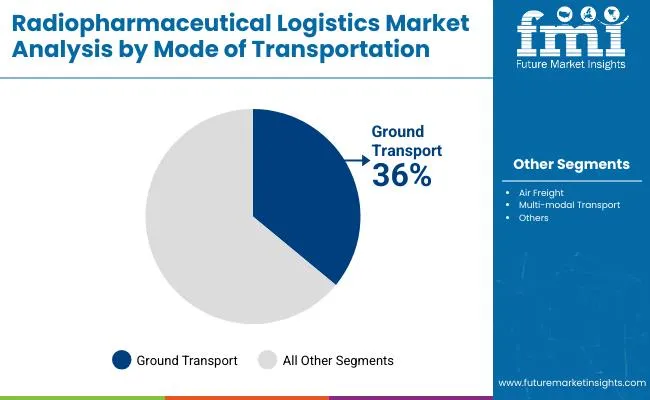
| Mode of Transportation | Market Share (%) |
|---|---|
| Ground Transport | 36.0% |
| Air Freight | 30.0% |
| Multi-modal Transport | 10.0% |
Air Freight has emerged as the leading mode of transportation in the global radiopharmaceutical logistics market and is projected to account for approximately 48.6% of total market share in 2025, driven by the increasing need for fast, reliable, and compliant delivery of time-sensitive isotopes. As radiopharmaceuticals like Fluorine-18, Gallium-68, and Carbon-11 require delivery within a few hours of synthesis, air transport has become essential to meeting the tight timelines demanded by PET and SPECT procedures. This dominance is further reinforced by the rising international movement of radioisotopes, especially in regions where in-house cyclotron infrastructure is limited. Countries in Asia Pacific, Latin America, and parts of Eastern Europe rely on regional or global suppliers, necessitating air freight for efficient cross-border delivery.
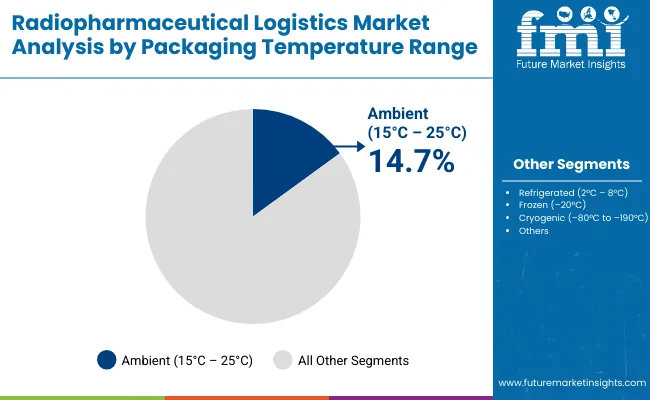
| Packaging Temperature Range | Market Share (%) |
|---|---|
| Ambient (15°C - 25°C) | 14.7% |
| Refrigerated (2°C - 8°C) | 43.6% |
| Frozen (-20°C) | 32.9% |
| Cryogenic (-80°C to -190°C) | 8.8% |
Refrigerated Packaging (2°C - 8°C) is expected to remain the largest and most critical temperature range segment in the global radiopharmaceutical logistics market, accounting for approximately 43.6% of market share in 2025. This segment is driven by the widespread use of diagnostic and therapeutic radiopharmaceuticals that require stable, low-temperature conditions to maintain potency and shelf life during transit. Most commonly used isotopes including Lutetium-177, Iodine-123, and Technetium-99m-based compounds, require refrigerated transport to ensure chemical stability and radiological efficacy, especially in multi-leg journeys between cyclotrons, radiopharmacies, and end-use clinical sites. The sustained dominance of the refrigerated segment is being reinforced by:
| End User | Market Share (%) |
|---|---|
| Hospitals | 42.9% |
| Diagnostic Imaging Centers | 22.1% |
| Cancer Clinics / Radiotherapy Centers | 12.6% |
| Radiopharmacies & Centralized Preparation Labs | 9.3% |
| Research Institutes & CROs | 7.0% |
| CDMOs/CMOs | 6.1% |
Hospitals have emerged as the leading end user in the global radiopharmaceutical logistics market and are projected to account for approximately 42.9% of total market share in 2025, owing to their central role in diagnostic imaging and nuclear medicine-based therapies. As primary sites for PET/CT and SPECT scans, as well as inpatient radionuclide therapies, hospitals rely heavily on the timely and safe delivery of radiopharmaceuticals often on a daily or even intra-day basis.
This dominance is underpinned by the rapid rise in oncology and cardiology imaging procedures, which has significantly expanded the volume and frequency of isotope deliveries to hospital-based nuclear medicine departments. Furthermore, the growing clinical adoption of radiotheranostics, such as Lutetium-177 DOTATATE and Actinium-225, has increased hospital dependency on reliable, compliant logistics networks that can support specialized cold chain requirements.
Growing Use in Radiotheranostics and Molecular Imaging
Radiotheranosticsa convergence of diagnostics and targeted therapy is reshaping oncology and precision treatment. Techniques like PET (Positron Emission Tomography) and SPECT (Single-Photon Emission Computed Tomography), enhanced by targeted radiotracers, enable real-time visualization of tumors and guide therapeutic planning. Imaging modalities that combine functional insight with anatomical detail (e.g., PET/CT, SPECT/CT) are becoming clinical staples due to heightened sensitivity and specificity. This rapid adoption of imaging and theranostic techniques increases the volume and frequency of radiopharmaceutical shipments, driving demand for advanced logistics solutions especially those capable of meeting tight delivery schedules and stringent temperature requirements.
Beyond routine imaging, theranostics plays a pivotal role in clinical trials and personalized medicine programs. Over 600 active clinical trials globally now leverage molecular imaging spanning oncology, neurology, cardiology, and infectious diseases. Applications include PET tracers like ^18F‑FDG, ^68Ga‑PSMA, and newer compounds such as ^177Lu-DOTATATE.These trials are further catalyzing demand for radiopharmaceutical shipments that must maintain cold chain integrity and rapid delivery. Personalized radiopharmaceutical therapy also relies on AI-backed modeling for dosimetry and treatment optimization. Emerging research highlights data-driven frameworks to refine radiopharmaceutical delivery and dosing, reinforcing the need for responsive and adaptive logistics capabilities.
Limited Infrastructure in Emerging Markets
One of the most significant barriers impeding the growth of radiopharmaceutical logistics in emerging markets is the absence of reliable cold chain infrastructure. Maintaining temperature control from refrigerated (2 °C-8 °C) to frozen or ultra-cold conditions, is essential to preserve the integrity and efficacy of radiopharmaceuticals during transit. However, many regions in Sub-Saharan Africa, Southeast Asia, and parts of Latin America lack consistent power supplies, modern refrigerated storage facilities, and temperature-controlled transport fleets.
For example, in Africa, frequent power outages and limited access to cold storage contribute to widespread vaccine spoilage, a challenge that directly translates to radiopharmaceutical fragility. Such infrastructure fragility threatens therapeutic efficacy and increases the risk of dose degradation, making cold chain reliability a pivotal logistics concern.
Beyond cold storage, transportation networks needed to support real-time delivery of short half-life isotopes are often inadequate. In regions like India, even expanding vaccine cold-storage chains reveals gaps: only a fraction of required facilities exist, and heat-induced failures during transport are common. Logistical breakdowns such as those encountered in rural or remote areas can delay radiopharmaceutical deliveries, compromising treatment schedules. Consequently, the lack of integrated cold chain and transport infrastructure becomes a critical bottleneck to market expansion in these regions.
Integration of Real-Time Tracking and Cold Chain Monitoring Technologies
Radiopharmaceuticals especially those used in molecular imaging (such as PET and SPECT tracers) and theranosticsrequire precise temperature control and timely delivery to ensure efficacy, safety, and patient outcomes. These compounds often have extremely short half-lives (e.g., Fluorine‑18 with ~110 minutes, Gallium‑68 around 68 minutes), making preservation of their activity during transit a logistical imperative. Even minor deviations in temperature or delivery time can degrade dose potency, risk regulatory non‑compliance, or jeopardize a diagnostic or therapeutic procedure. This complexity has driven logistics providers and healthcare systems to adopt increasingly sophisticated real‑time tracking and cold‑chain monitoring technologies. Collectively, these capabilities are helping transform radiopharmaceutical logistics from reactive, batch-based systems into intelligent, responsive, and data‑driven supply chains.
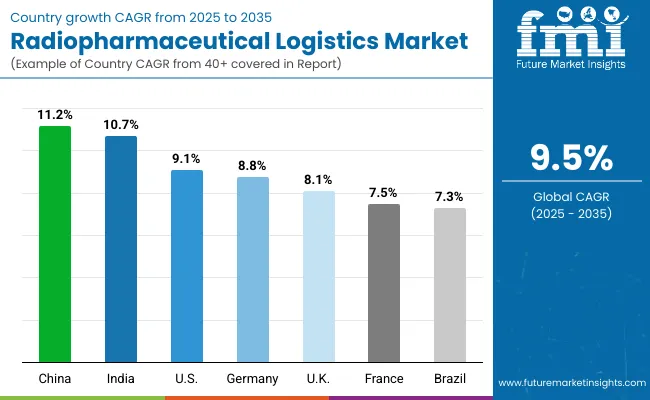
| Countries | CAGR |
|---|---|
| USA | 9.1% |
| Brazil | 7.3% |
| China | 11.2% |
| India | 10.7% |
| Europe | 7.5% |
| Germany | 8.8% |
| France | 7.5% |
| UK | 8.1% |
The Asia Pacific region is set to emerge as the fastest-growing region in the global radiopharmaceutical logistics market, projected to grow at a CAGR of 11.2% in China and 10.7% in India between 2025 and 2035. These are the highest national growth rates globally, signaling rapid expansion in demand for efficient and compliant transport of radiopharmaceuticals. This acceleration is primarily driven by:
Europe is expected to experience steady growth at a CAGR of 7.5% between 2025 and 2035. The regional market is projected to expand from USD 251.4million in 2025 to USD 379.6million by 2035, adding approximately USD 128.1million in value.
Europe’s growth is supported by its mature diagnostic imaging landscape, expanding theranostic usage, and a network of centralized radiopharmacies, which create repeat demand for highly controlled, refrigerated and cryogenic delivery services.
North America remains the largest and most established regional market, led by the United States, which will grow at a CAGR of 9.1%. The USA market is projected to expand from USD 477.8 million in 2025 to USD 1,141.5 million by 2035, representing an absolute growth of USD 663.7 million over the decade.
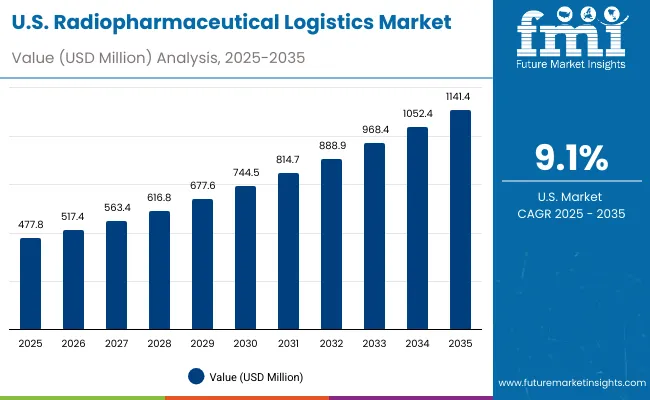
The Radiopharmaceutical Logistics Market in the USA is forecasted to grow at a robust CAGR of 9.1% between 2025 and 2035, expanding from USD 477.8 million in 2025 to USD 1,141.5 million by 2035. This strong growth trajectory is primarily driven by the increasing demand for time-critical delivery services of diagnostic and therapeutic isotopes, coupled with rising adoption of molecular imaging and radiotheranostics across healthcare systems.
Hospitals, cancer centers, and imaging facilities across the USA are heavily reliant on same-day delivery of short half-life isotopes such as Fluorine-18 and Gallium-68, especially for PET and SPECT scans. As most radiopharmaceuticals are synthesized off-site, compliance with NRC, DOT, and USP guidelines, along with uninterrupted cold chain maintenance, has become central to operational workflows. These factors are pushing logistics providers to enhance air freight and ground-based transport capabilities while integrating real-time tracking, temperature monitoring, and tamper-proof packaging solutions.
The radiopharmaceutical logistics market in the United Kingdom is projected to grow at a CAGR of 8.1% between 2025 and 2035, supported by NHS England’s strategic push toward enhancing nuclear medicine infrastructure and broadening access to PET/CT imaging services across regional and tertiary care centers. As part of its Imaging Transformation Program and Community Diagnostic Centers (CDCs) expansion plan, the NHS is facilitating broader access to time-sensitive radiotracers-driving up the demand for reliable and compliant logistics services.
The UK market is expected to increase its share of the European radiopharmaceutical logistics market, from 18.7% in 2025 to approximately 19.1% by 2035, supported by consistent investment in imaging capacity and streamlined procurement of isotopes via centralized radiopharmacies. NHS Trusts, private imaging providers, and oncology centers are increasingly relying on air freight and secure ground transport solutions to enable same-day delivery of diagnostic tracers such as Fluorine-18 and Gallium-68, as well as therapeutic isotopes like Lutetium-177 used in radioligand therapy. Compliance with MHRA guidelines, IR(ME)R regulations, and Good Distribution Practice (GDP) for radiopharmaceuticals is shaping procurement criteria for logistics providers.
The radiopharmaceutical logistics market in Germany is forecast to grow at a CAGR of 8.8% between 2025 and 2035, increasing from a significant base to further consolidate its position as the largest national market in Europe, with a projected market share rising from 28.2% in 2025 to 28.9% by 2035. Growth is being accelerated by the country’s deeply institutionalized nuclear medicine infrastructure, strong PET/CT imaging capacity, and progressive federal investments under Germany’s Krankenhauszukunftsgesetz (KHZG or Hospital Future Act), which is directly supporting digital and physical healthcare modernization, including advanced logistics capabilities for radiopharmaceuticals.
Germany’s high volume of PET and SPECT scans driven by early detection protocols in oncology and neurology-has created a robust demand for time-sensitive, compliance-led transportation solutions. This is particularly vital given the short half-life of diagnostic tracers like Fluorine-18, which require delivery within 4-6 hours post-synthesis. Coupled with growing demand for radiotheranostics (e.g., Lutetium-177, Actinium-225), Germany is seeing a sharp rise in temperature-controlled and cryogenic logistics infrastructure investments, especially in urban academic medical centers and regional radiopharmacies.
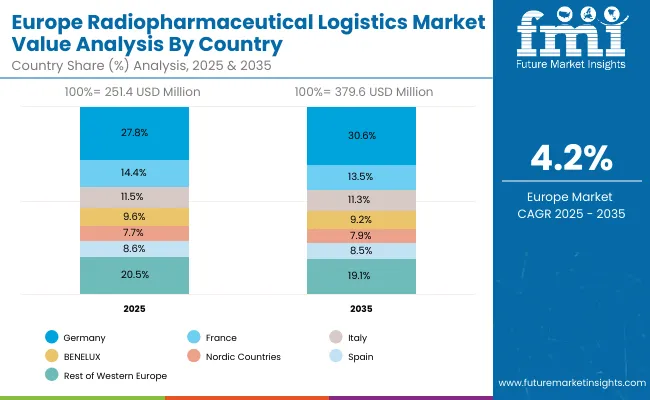
| Europe Countries | 2025 |
|---|---|
| Germany | 27.8% |
| France | 14.4% |
| Italy | 11.5% |
| BENELUX | 9.6% |
| Nordic Countries | 7.7% |
| Spain | 8.6% |
| Rest of Western Europe | 20.5% |
| Europe Countries | 2035 |
|---|---|
| Germany | 30.6% |
| France | 13.5% |
| Italy | 11.3% |
| BENELUX | 9.2% |
| Nordic Countries | 7.9% |
| Spain | 8.5% |
| Rest of Western Europe | 19.1% |
The radiopharmaceutical logistics market in India is expected to grow at a CAGR of 10.7% between 2025 and 2035, making it one of the fastest-growing national markets globally. This rapid expansion is driven by India’s aggressive growth in tertiary hospitals, oncology centers, and PET/CT diagnostic networks, especially across Tier 1 and Tier 2 cities. The rising demand for molecular imaging, along with increased investments in radiotheranostic capabilities, is placing pressure on logistics providers to scale up time-sensitive, cold chain-compliant delivery systems for diagnostic and therapeutic radioisotopes.
India’s strategic push to become a global hub for nuclear medicine manufacturing and clinical application-through government-funded institutions like BARC (Bhabha Atomic Research Centre) and Board of Radiation & Isotope Technology (BRIT)-has led to the expansion of regional radiopharmacies and centralized isotope production centers. These hubs are increasingly servicing a wider network of public and private healthcare providers, creating complex logistics demands for refrigerated and cryogenic transport solutions, especially for isotopes such as Fluorine-18, Gallium-68, Lutetium-177, and Yttrium-90.
China is projected to be the fastest-growing country in the global radiopharmaceutical logistics market, with a CAGR of 11.2% from 2025 to 2035. This exceptional growth is underpinned by robust government policy frameworks like “Healthy China 2030”, aggressive national investments in oncology and diagnostic imaging, and the widespread expansion of PET/CT capacity across both urban and county-level hospitals. As China emerges as a leading hub for molecular imaging and radiotheranostics, the need for time-sensitive, cold chain-enabled logistics infrastructure is rapidly intensifying.
The market growth is further accelerated by China's increasing clinical deployment of theranostic isotopes-such as Lutetium-177 and Actinium-225-as well as higher demand for Fluorine-18 FDG in PET-based cancer diagnostics. As of 2025, major hospital systems in Tier 1 cities like Beijing, Shanghai, Guangzhou, and Chengdu are upgrading their nuclear medicine departments and establishing in-house or satellite radiopharmacies. This is catalyzing the need for reliable, temperature-controlled delivery systems that can comply with NMPA (National Medical Products Administration) and IAEA guidelines.
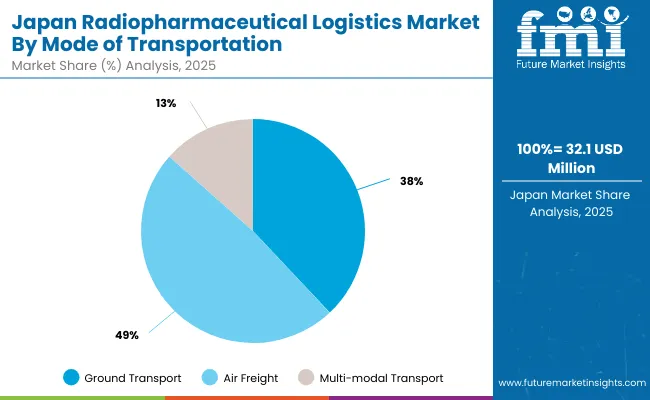
Japan’s radiopharmaceutical logistics market is projected to reach USD 32.1 million in 2025, growing at a CAGR of 5.1% through 2035, supported by the country’s commitment to precision diagnostics, its expanding nuclear medicine infrastructure, and the unique logistical demands created by an aging population. As one of the most advanced healthcare systems globally, Japan prioritizes high regulatory compliance, worker safety, and timely access to diagnostic and therapeutic isotopes-factors that continue to shape the evolution of radiopharmaceutical logistics networks across the country.
Japan’s radiopharmaceutical supply chain has historically been highly centralized, with a focus on domestic production of isotopes like Technetium-99m, Fluorine-18, Gallium-67, and Iodine-123. However, as demand for PET imaging and theranostics agents such as Lutetium-177 and Actinium-225 continues to grow, hospitals and imaging centers are increasingly depending on time-sensitive logistics providers equipped to handle complex cold chain deliveries under stringent PMDA (Pharmaceuticals and Medical Devices Agency) and MHLW regulations.
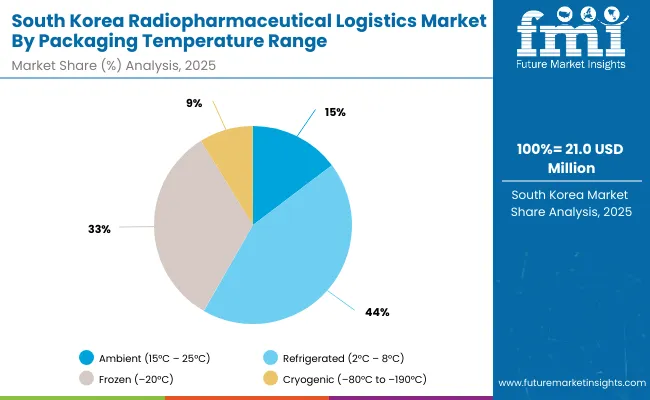
The radiopharmaceutical logistics market in South Korea is estimated at approximately USD 21.0million in 2025, capturing about 1.9% of the global market share. This reflects steady growth fueled by national healthcare policies focused on enhancing radiopharmaceutical availability and safe handling protocols.

The Radiopharmaceutical Logistics Market is moderately fragmented, with a few dominant players, several established mid-sized providers, and a growing base of niche-focused specialists competing across radiopharmaceutical transportation, handling, and time-critical delivery services.
PHSE S.r.l. holds a commanding 34.9% market share, driven by its expertise in time- and temperature-sensitive radiopharmaceutical logistics. The company’s strategy focuses on expanding its global footprint, investing in dedicated cold-chain networks, and leveraging real-time tracking technologies for critical isotopes and PET tracers. PHSE has also strengthened partnerships with radiopharmaceutical manufacturers and nuclear medicine departments to ensure end-to-end compliance with radiation safety and international transport regulations.
Companies like Life Couriers, Orchestra Life Sciences, MNX, and B.P.L. GmbH cater to hospitals, imaging centers, and nuclear medicine facilities requiring high-frequency, regional delivery models. These players focus on rapid response capabilities, integration of 24/7 monitoring systems, and expansion of dedicated handling hubs to compete effectively against larger networks. Their strategies also emphasize collaboration with pharmaceutical distributors to cover last-mile delivery gaps in emerging markets.
Firms such as Corvidae Logistics, Kalitta Charters, American Expediting, AirNet II LLC, Medi-Ops LLC, GTA Air Inc., and Lab Carriers specialize in customized transport services for low-volume, high-priority radiopharmaceutical consignments. These companies differentiate themselves through on-demand charter solutions, specialized radiation handling certifications, and flexibility in cross-border regulatory navigation. Their strength lies in serving niche geographies, small-scale PET centers, and academic nuclear medicine institutes.
Key Developments
| Item | Value |
|---|---|
| Quantitative Units | USD 1,106.0 million |
| Service Type | Standard Delivery Services, Time-critical Delivery Services |
| Mode of Transportation | Ground Transport, Air Freight, and Multi-modal Transport |
| Packaging Temperature Range | Ambient (15°C - 25°C), Refrigerated (2°C - 8°C), Frozen (-20°C), and Cryogenic (-80°C to -190°C) |
| End User | Hospitals, Diagnostic Imaging Centers, Cancer Clinics / Radiotherapy Centers, Radiopharmacies & Centralized Preparation Labs, Research Institutes & CROs, and CDMOs/CMOs |
| Regions Covered | North America, Latin America, Western & Eastern Europe, East Asia, South Asia & Pacific, Middle East & Africa |
| Countries Covered | USA, Brazil, China, India, Germany, France, UK etc. |
| Key Companies Profiled | PHSE S.r.l ., Life Couriers, Orchestra Life Scienc es, MNX, a UPS Company, Corvidae Logistics, Kalitta Charters., American Expediting, AirNet II LLC., Medi -Ops, LLC., GTA Air, Inc., Lab Carriers, and B.P.L. GmbH |
| Additional Attributes | Dollar sales by service type and region s, Hospitals and Diagnostic Imaging Centers: remain the largest end users for logistics, correlating with expanded procedural volumes-and in Asia Pacific, accounting for ~38-44% of end-user share by 2035 . The combination of domestic production capacity and decentralized distribution networks is amplifying demand for standardized logistics models that can meet cold chain and regulatory requirements efficiently. |
The global radiopharmaceutical logistics market is estimated to be valued at USD 1,106.0 million in 2025.
The market size for radiopharmaceutical logistics market is projected to reach USD 2,740.6 million by 2035.
The radiopharmaceutical logistics market is expected to grow at a CAGR of 9.5% during this period.
Service Type include Standard Delivery Services, and Time-critical Delivery Services
The Air Freight segment is projected to command 36.0% of the market in 2025.






Our Research Products

The "Full Research Suite" delivers actionable market intel, deep dives on markets or technologies, so clients act faster, cut risk, and unlock growth.

The Leaderboard benchmarks and ranks top vendors, classifying them as Established Leaders, Leading Challengers, or Disruptors & Challengers.

Locates where complements amplify value and substitutes erode it, forecasting net impact by horizon

We deliver granular, decision-grade intel: market sizing, 5-year forecasts, pricing, adoption, usage, revenue, and operational KPIs—plus competitor tracking, regulation, and value chains—across 60 countries broadly.

Spot the shifts before they hit your P&L. We track inflection points, adoption curves, pricing moves, and ecosystem plays to show where demand is heading, why it is changing, and what to do next across high-growth markets and disruptive tech

Real-time reads of user behavior. We track shifting priorities, perceptions of today’s and next-gen services, and provider experience, then pace how fast tech moves from trial to adoption, blending buyer, consumer, and channel inputs with social signals (#WhySwitch, #UX).

Partner with our analyst team to build a custom report designed around your business priorities. From analysing market trends to assessing competitors or crafting bespoke datasets, we tailor insights to your needs.
Supplier Intelligence
Discovery & Profiling
Capacity & Footprint
Performance & Risk
Compliance & Governance
Commercial Readiness
Who Supplies Whom
Scorecards & Shortlists
Playbooks & Docs
Category Intelligence
Definition & Scope
Demand & Use Cases
Cost Drivers
Market Structure
Supply Chain Map
Trade & Policy
Operating Norms
Deliverables
Buyer Intelligence
Account Basics
Spend & Scope
Procurement Model
Vendor Requirements
Terms & Policies
Entry Strategy
Pain Points & Triggers
Outputs
Pricing Analysis
Benchmarks
Trends
Should-Cost
Indexation
Landed Cost
Commercial Terms
Deliverables
Brand Analysis
Positioning & Value Prop
Share & Presence
Customer Evidence
Go-to-Market
Digital & Reputation
Compliance & Trust
KPIs & Gaps
Outputs
Full Research Suite comprises of:
Market outlook & trends analysis
Interviews & case studies
Strategic recommendations
Vendor profiles & capabilities analysis
5-year forecasts
8 regions and 60+ country-level data splits
Market segment data splits
12 months of continuous data updates
DELIVERED AS:
PDF EXCEL ONLINE
Radiopharmaceutical Dispensing System Market Size and Share Forecast Outlook 2025 to 2035
Logistics Packaging Market Size and Share Forecast Outlook 2025 to 2035
Radiopharmaceutical Market Forecast and Outlook 2025 to 2035
Logistics Robots Market Size and Share Forecast Outlook 2025 to 2035
Logistics Visibility Software Market Size and Share Forecast Outlook 2025 to 2035
Key Players & Market Share in the Logistics Packaging Industry
Logistics Outsourcing Market Analysis - Growth & Forecast 2025 to 2035
Logistics Visualization System Market
Logistics Automation Market
Cash Logistics Market Size and Share Forecast Outlook 2025 to 2035
Rail Logistics Market Size and Share Forecast Outlook 2025 to 2035
Intralogistics Automation Solutions Market Size and Share Forecast Outlook 2025 to 2035
Drone Logistics & Transportation Market Size and Share Forecast Outlook 2025 to 2035
Smart Logistics Services Market Size and Share Forecast Outlook 2025 to 2035
Green Logistics Market Size and Share Forecast Outlook 2025 to 2035
Event Logistics Market Size and Share Forecast Outlook 2025 to 2035
Cloud Logistics Market Insights – Demand & Growth Forecast 2025 to 2035
Timber Logistics Market Size and Share Forecast Outlook 2025 to 2035
Retail Logistics Market Size and Share Forecast Outlook 2025 to 2035
Secure Logistics Market Size and Share Forecast Outlook 2025 to 2035

Thank you!
You will receive an email from our Business Development Manager. Please be sure to check your SPAM/JUNK folder too.
Chat With
MaRIA